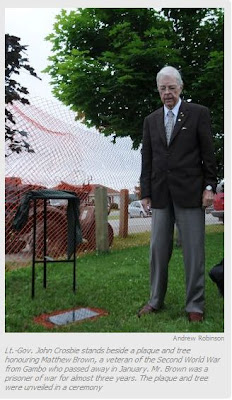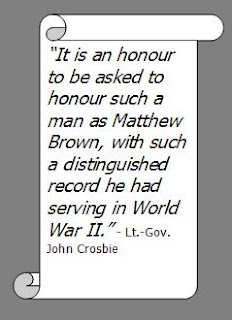Lt.-Gov. John Crosbie was in Gambo last Sunday to help unveil a plaque honouring the life of a Second World War veteran who spent three years overseas as a prisoner of war. Matthew Thomas Brown, 87, died at his home in Gambo on Jan. 4. Known as Uncle Matt within the community, he was predeceased by his wife Mabel Brown, who passed away three years ago.
 “It is an honour to be asked to honour such a man as Matthew Brown, with such a distinguished record he had serving in World War II,” said the lieutenant-governor following the unveiling of the plaque during a ceremony held at the Village Green. In addition to the plaque, a tree has also been planted in Mr. Brown’s honour.
“It is an honour to be asked to honour such a man as Matthew Brown, with such a distinguished record he had serving in World War II,” said the lieutenant-governor following the unveiling of the plaque during a ceremony held at the Village Green. In addition to the plaque, a tree has also been planted in Mr. Brown’s honour.The event was held as a part of the annual Smallwood Days celebration.“Anybody who has been to Beaumont Hamel knows what all our veterans of World War I and II suffered,” said Lt.-Gov. Crosbie.
At the age of 17, Mr. Brown left Gambo and his forestry work for the United Kingdom to train with the British Royal Navy in England and Scotland as part of the Second World War effort. He was deployed to serve on the HMS Bedouin, a Tribal-class destroyer. It served in the 1940 Battle of Narvik off the Norwegian coastline.
The ship, on its way to Malta, was sunk by a pair of Italian torpedo bombers on June 15, 1942, leaving 28 dead.
After nine hours in the water, Mr. Brown was one of 213 men taken as a prisoner of war by the Italian Navy, the beginning of what became a three-year ordeal for the young man.
He was brought to Italy, and once British forces gained control of the country, he was transported to Poland, where he took on forced labour duties in a coal mine for 19 months.
On Dec. 26, 1944, Mr. Brown began what was called a ‘death march’ through Germany, Czechoslovakia, and Austria. The forced winter march went on for 1,600 miles. He obtained his freedom on May 1, 1945.
Nelson Granter, a member of Branch #41 Royal Canadian Legion in Eastport, said it was hard not to know Mr. Brown through his continued presence in the community, particularly at events recognizing past and present war efforts.
“He has been a tribute to the Royal Canadian Legion, and he has constantly encouraged and pushed for remembrance.”
Hardships at home

Mr. Granter put into perspective how Mr. Brown’s experience in Europe affected himself and those at home. Initial letters sent home said he was missing, with no information concluding whether Mr. Brown was dead or alive.
“We seldom think of the home front. When Matthew Brown and his good buddy, Sylvester Hiscock, sailed away to war, they left people at home – people who were concerned and worried.”
Mr. Granter read a letter sent from the Royal Naval Barracks in Chatham, England shortly after the events on the HMS Bedouin.
“Dear Madame. I deeply regret having to inform you that your son, Matthew Thomas Brown, ordinary seaman, has been reported as missing while on war service. There is insufficient evidence at the present time to show whether your son may be alive or not.”
A letter dated July 12, 1942 offered a more encouraging story, as read by Mr. Granter.
“Dear Madame. With reference to my letter of the first of July, official information has now been received that your son is a prisoner of war in Italy.”
Communications were eventually received from Mr. Brown, but were heavily censored to paint a more pleasant picture of what took place during his stint as a prisoner of war.
“In the postcards, everything sounded so rosy. They said, ‘I am doing great. Everything is good. I’m well cared for.’ But that was a false-front, because from prisoner of war camp, postcards would be censored.”
In fact, Mr. Granter said Mr. Brown spent 13-hour work days cold and hungry. The hunger reduced him to eating lice, and Mr. Granter said Mr. Brown used to jokingly refer to the lice as his best friend, as it was the only item a prisoner had plenty of.
In the years since the war, Mr. Brown was known for appearing at Remembrance Day ceremonies, and at the most recent one prior to his death, he spoke to students at Smallwood Academy in Gambo.
“He presented his original navy (beret) to the school. Uncle Matt didn’t normally say much, but that day ... it was just awesome,” said Mr. Granter. “There was absolute silence, and I think even the youngest children knew they were listening to someone significant. “Unfortunately, two months later we lost Uncle Matt, but Uncle Matt’s memory will live forever in Gambo.”
Published on August 5th, 2010 by "The Gander Beacon"
Submitted by Roderick Brentnall
1 comment:
Matt Brown, a very humble man, was a hero, and deserves to be commemorated at every community event. Matt worked with my father Lew Saunders and was a frequent visitor to our home.
Post a Comment